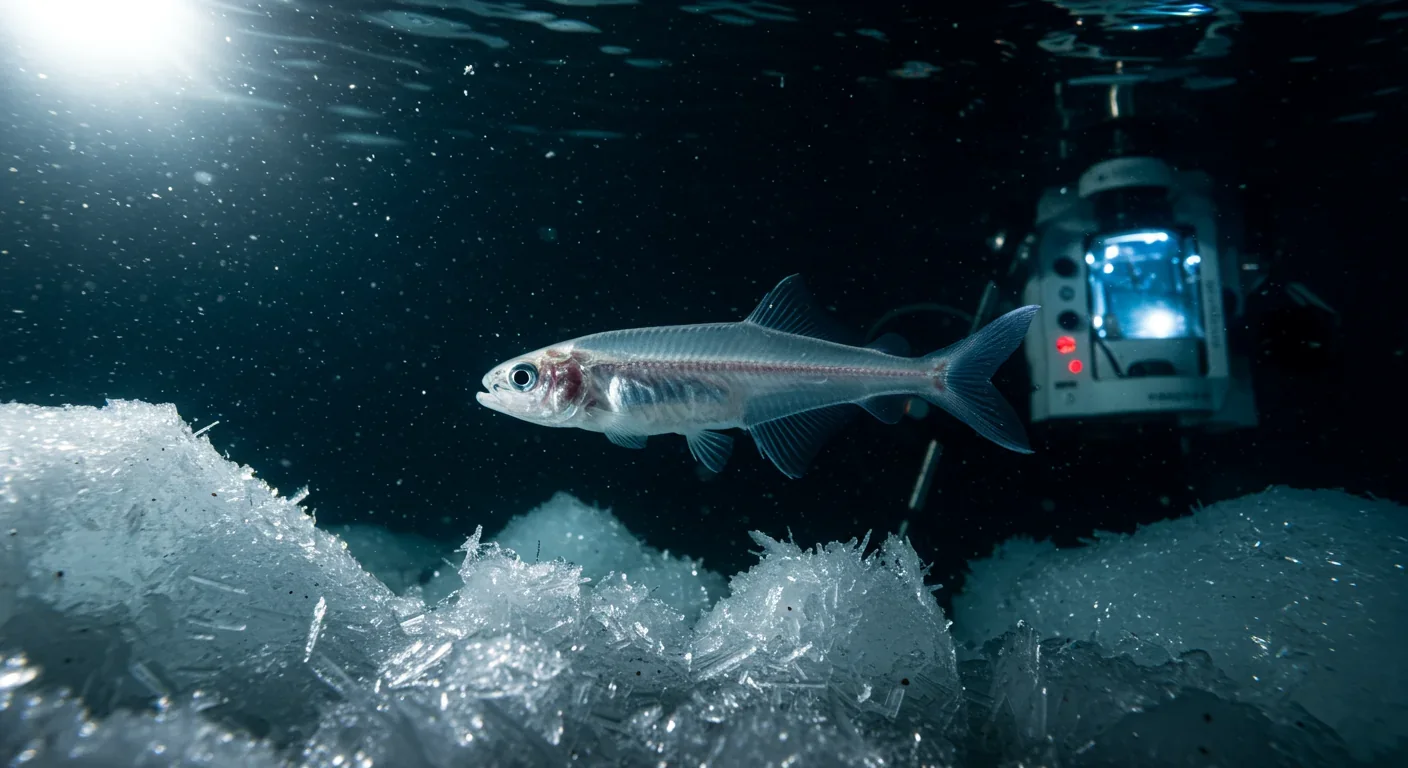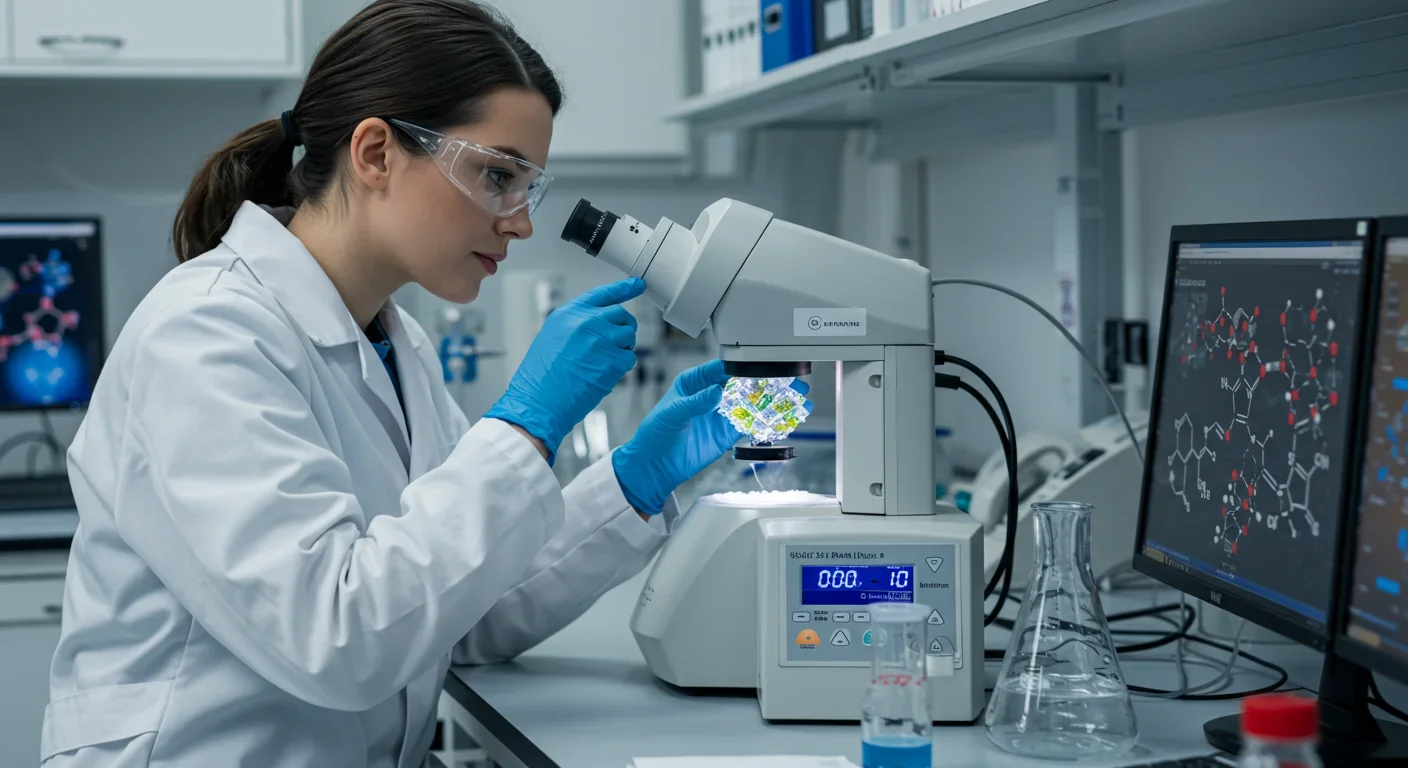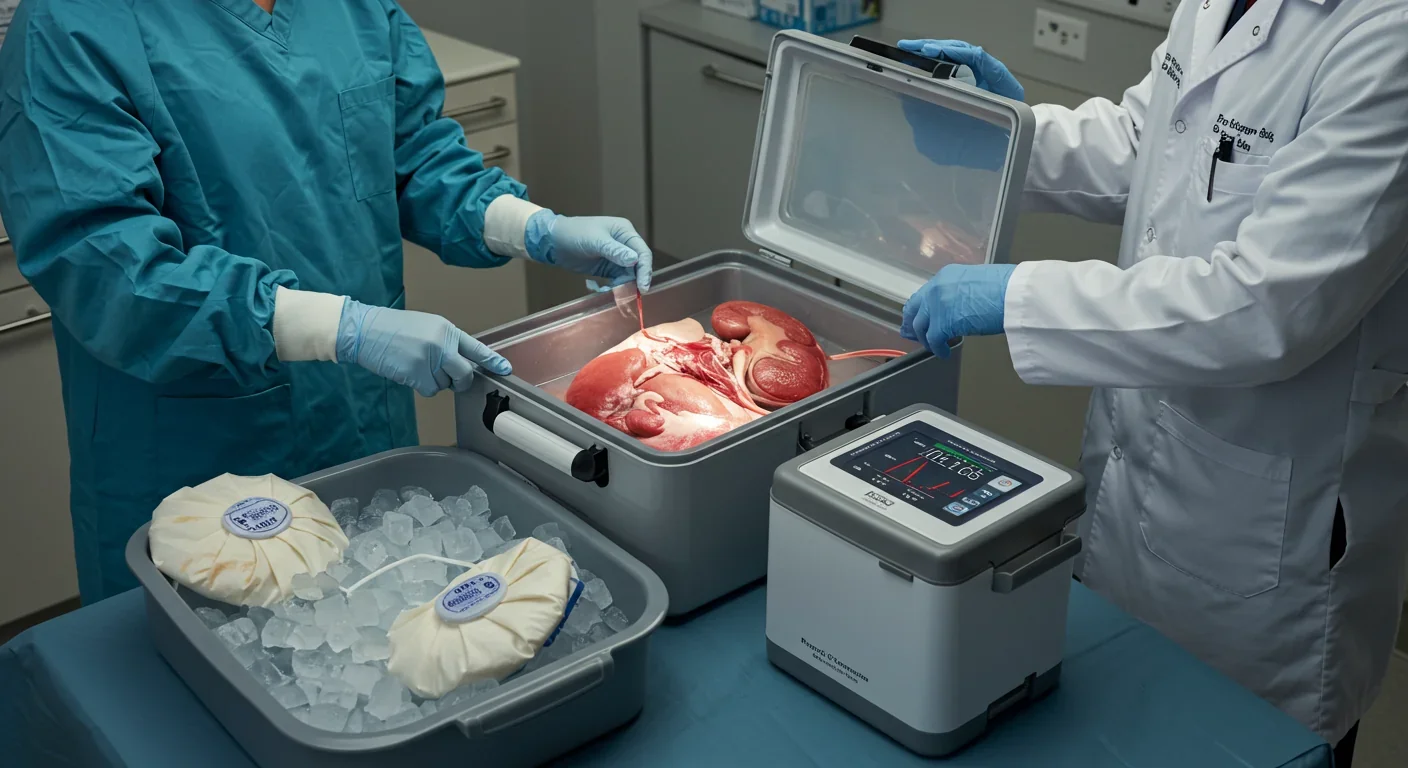Forest Biological Clocks: Ecosystems That Keep Time

TL;DR: Antarctic fish survive subzero waters using antifreeze proteins that physically block ice crystal growth. Scientists are now adapting these molecular marvels to preserve organs, protect crops, and revolutionize cryopreservation.

Imagine swimming in water so cold it should turn you into a popsicle. That's the daily reality for fish in Earth's polar seas, where temperatures regularly drop to -2°C. Yet these creatures thrive in conditions that would kill most species within minutes. Their secret? Molecular innovations so elegant that scientists are now copying them to revolutionize organ transplants, protect crops from frost, and preserve cells for decades.
Antarctic notothenioid fish make up 90% of fish biomass around Antarctica's continental shelf, and they owe their dominance to tiny proteins that perform an extraordinary trick: they stop ice from forming inside their bodies. These antifreeze proteins (AFPs) represent evolution's most impressive responses to climate change, and understanding how they work is opening doors we didn't know existed.
Seawater freezes at -1.9°C because of its salt content. Your blood would freeze at -0.7°C. That's a problem when you're a fish living in waters that regularly hit -2°C. Normal biological tricks like adding more salt or sugar only get you so far before creating new cellular problems.
AFPs work differently. Instead of lowering the freezing point chemically, they physically interfere with ice crystal formation. When water molecules start arranging into the rigid lattice of ice, AFPs bind directly to growing crystal surfaces. The proteins don't melt ice, but they prevent it from growing larger.
The mechanism is called adsorption-inhibition. AFPs attach to specific ice crystal faces through hydrogen bonds and van der Waals forces. Once bound, they create a curved interface between ice and surrounding water. This curvature increases the energy required for water molecules to join the ice lattice, effectively lowering the temperature at which ice can grow without changing the freezing point itself.
Different AFP types have distinct structures. Type I AFPs are α-helical with alanine-rich regions. Type II AFPs contain cysteine-rich globular structures, while Type III uses a compact β-sandwich fold. Each type binds ice differently, but ice crystals in the blood remain microscopic and harmless.
Here's where it gets weird. Researchers discovered that AFPs also prevent ice from melting. Fish carry tiny ice crystals inside their bodies for their entire lives because the proteins prevent both freezing and thawing. Scientists call this "superheating" because ice persists at temperatures above its normal melting point. It's the first natural example of this phenomenon, previously only seen in laboratories.
Perhaps the most fascinating aspect: evolution invented AFPs multiple times, independently. At least four separate fish lineages developed Type I antifreeze proteins from completely different genetic starting points. Flounders, sculpins, cunners, and snailfish all faced the same problem when Northern Hemisphere glaciation kicked in 2-3 million years ago, and they all arrived at similar solutions.
Convergent evolution of this sophistication is rare. The cunner AFP evolved from gene duplication of GIMAP family genes, which normally have nothing to do with ice binding. Snailfish AFPs originated from transposable elements, essentially repurposed genetic parasites. Both pathways led to proteins with the characteristic alanine-rich α-helix needed for ice binding.
This parallel innovation happened because selective pressure was enormous. When polar waters cooled below fish blood's freezing point, you either evolved protection or went extinct. The fossil record shows dramatic turnover in polar fish populations during glaciation, with AFP-bearing lineages rapidly replacing species that couldn't adapt.
Antarctic notothenioids went further. They've restructured their entire physiology around AFPs. These fish possess aglomerular kidneys that lack filtering structures most vertebrates use, which would flush AFPs out. They've also undergone massive gene duplication, carrying 3 to 300 times more copies of stress-response genes than warm-water relatives.
The genetic commitment is staggering. When scientists analyzed the transcriptomes of Antarctic toothfish tissues, they found that a small set of genes dominated expression patterns across all tissue types. The fish essentially runs its metabolism on overdrive for a handful of critical adaptations, with AFP production at the center.

The biotechnology applications of AFPs are where scientific curiosity meets practical impact. Consider organ transplantation. Currently, donated organs survive only a few hours outside the body before irreversible cellular damage occurs. Cooling extends this window, but ice formation destroys cell membranes and tissue structure.
AFPs might change that equation. Researchers at the University of New Hampshire are working on AFP-enhanced preservation solutions that could keep organs viable for days rather than hours. Preliminary experiments with type III AFP from ocean pout show promising results in preventing ice damage during freeze-thaw cycles.
The challenge is getting AFPs to work at the right concentrations and temperatures. Fish produce these proteins at levels fine-tuned by millions of years of evolution. Synthetic production requires figuring out optimal dosing, stability, and compatibility with existing preservation solutions.
Crop protection offers another frontier. Frost damage costs agriculture billions annually, particularly in regions where unexpected freezes devastate harvests. Genetic engineering could theoretically introduce AFP genes into crops, providing built-in freeze tolerance.
Strawberries, tomatoes, and potatoes have been tested with AFP transgenes. Results are mixed. Some plants show improved freeze tolerance, surviving temperatures that would kill unmodified varieties. Others show no benefit, or the energy cost of AFP production reduces overall yield.
Then there's cryopreservation. Freezing cells and tissues for long-term storage is critical for fertility treatments, blood banking, and preserving rare cell lines. Ice crystal formation remains the biggest obstacle because crystals puncture cell membranes and disrupt intracellular structures.
Adding AFPs to cryoprotectant solutions reduces ice crystal size and improves cell survival after thawing. This is being explored for preserving stem cells, oocytes, and blood products. The proteins work synergistically with traditional cryoprotectants like DMSO and glycerol, offering better protection at lower concentrations.
Commercial interest in AFPs has spawned a small industry. Companies are developing AFP-based products, from ice cream additives that create smoother textures to coatings for frozen foods that reduce freezer burn. Food applications work because AFPs control ice crystal growth during freezing and storage.
But high-value applications are in medicine. X-Therma, a Harvard Medical School startup, uses AFP-inspired peptoids to develop organ preservation systems. In 2023, they successfully transported a pig kidney across the Atlantic using subzero storage technology, keeping it viable for more than three times the normal window.
The peptoid approach sidesteps challenges of using actual AFPs. Natural proteins can be unstable, expensive to produce, and may trigger immune responses. Peptoids can be synthesized chemically at scale with structures tailored for specific applications.
Academic research continues exploring fundamental physics of AFP-ice interactions. Recent studies using spin-labeled AFPs reveal molecular-level details of how these proteins recognize ice surfaces and bind with such specificity. The insights feed back into designing better synthetic versions.
One surprising finding: AFPs work better in some contexts than others, and we're still figuring out why. They're incredibly effective in preventing ice growth in blood and other biological fluids, but less effective in pure water or certain salt solutions. The presence of other biomolecules seems to enhance their activity, suggesting that evolution optimized these proteins for the specific chemical environment inside organisms.
Here's an irony: global warming that threatens so many species might pose unique challenges for these cold-adapted fish. You'd think warmer waters would be easier to handle, but it's not that simple.
Antarctic fish have paid a metabolic price for extreme cold adaptation. They've lost the ability to produce heat-shock proteins and other machinery that helps fish cope with temperature increases. Their gene expression profiles are so specialized for cold that even modest warming could overwhelm their physiology.
The anti-melt property creates another vulnerability. Because AFPs prevent internal ice from melting, fish carry microscopic ice crystals throughout their lives. Temperature records from McMurdo Sound show that for 11 years, ocean temperatures never rose high enough to melt this internal ice. But as polar waters warm, there's concern about what happens when temperatures cross that threshold.
Melting internal ice could trigger physiological stress cascades. Ice crystals have been present since early development, potentially influencing how tissues and organs are structured. Their sudden disappearance might be disruptive in unpredictable ways.
Some fish might adapt by reducing AFP production as waters warm, but that requires genetic changes that take many generations. Current warming pace may be too fast for evolutionary adaptation to keep up. We could see population crashes in species that have dominated polar ecosystems for millions of years.

The future of AFP research lies in synthetic biology. Rather than simply copying natural AFPs, scientists are designing new variants with enhanced properties. Computational models predict AFP structure and function, allowing researchers to test thousands of hypothetical proteins virtually before building real ones.
Machine learning is accelerating this process. By training algorithms on known AFP sequences and their ice-binding properties, researchers can identify which amino acid patterns are essential and which can be modified. This opens the door to custom-designed proteins optimized for specific applications.
One goal is creating AFPs that work at higher temperatures. Natural AFPs are most effective near freezing point, which limits usefulness in refrigerated storage of biologics. Engineering proteins that bind ice at 4°C or 10°C could extend shelf life of vaccines, blood products, and medications without freezing them.
Another direction is multifunctional proteins. What if you could design a molecule that prevents ice formation and protects cell membranes from cold damage? Or one that binds ice and has antimicrobial properties? Natural AFPs do one thing extremely well, but synthetic versions aren't constrained by evolutionary history.
Recent work on AFP applications in bioengineering has shown these proteins can be incorporated into hydrogels, coatings, and other materials. This moves beyond simply adding AFPs to solutions and toward building systems where proteins are integral structural components.
Within the next decade, AFP technology will likely touch your life in ways you don't see. The strawberries in your winter smoothie might resist frost damage because of genes borrowed from an Antarctic fish. Preserved cells in regenerative medicine treatments could survive thanks to AFP-enhanced cryoprotectants. An organ transplant that saves a family member's life might be possible because AFPs kept a donated kidney viable long enough.
The science is moving from "can we make this work?" to "how do we scale this up?" That's a crucial transition. Plenty of technologies work brilliantly in labs but fail when you try to manufacture them cheaply and reliably. AFPs have crossed that threshold in some applications and are approaching it in others.
Food technology will likely see the earliest widespread adoption. Ice cream applications are already commercial in some markets, and other frozen food applications are in late-stage development. These don't require regulatory approval processes as stringent as medical uses.
Medical applications will take longer because the bar for safety and efficacy is higher, as it should be. But pilot programs for AFP-enhanced organ preservation could begin within five years, with broader adoption following if results are positive.
Agricultural applications face unique hurdles because of public skepticism about genetic engineering of crops. Even if the science works perfectly, regulatory approval and market acceptance could be slow. That said, climate change is making frost events more unpredictable, which might increase demand for any technology that protects crops.
What AFPs really represent is a case study in how nature solves problems we barely knew existed. No human engineer would have thought to prevent ice formation by binding to crystal surfaces rather than changing the liquid's chemical properties. We would have focused on adding antifreeze chemicals, which is exactly what we do in radiators and airplane de-icing fluid.
Fish found a different solution because evolution explores every possibility simultaneously. Millions of random mutations across millions of organisms over millions of years is an exhaustive search algorithm that makes our best optimization software look primitive.
The convergent evolution of AFPs tells us these proteins represent a genuine solution, not a biological fluke. When multiple lineages independently arrive at the same answer, it suggests there may not be many alternatives. That's valuable information for synthetic biology: it narrows the design space and tells us where to focus engineering efforts.
The fish swimming through Antarctic waters right now carry the product of evolution's longest experiment in freeze tolerance. Their blood contains molecules representing millions of years of refinement, each generation testing variations until the result was nearly perfect. We're just beginning to appreciate what they can teach us, and what we might build from those lessons.

MOND proposes gravity changes at low accelerations, explaining galaxy rotation without dark matter. While it predicts thousands of galaxies correctly, it struggles with clusters and cosmology, keeping the dark matter debate alive.

Ultrafine pollution particles smaller than 100 nanometers can bypass the blood-brain barrier through the olfactory nerve and bloodstream, depositing in brain tissue where they trigger neuroinflammation linked to dementia and neurological disorders, yet remain completely unregulated by current air quality standards.

CAES stores excess renewable energy by compressing air in underground caverns, then releases it through turbines during peak demand. New advanced adiabatic systems achieve 70%+ efficiency, making this decades-old technology suddenly competitive for long-duration grid storage.

Our brains are hardwired to see patterns in randomness, causing the gambler's fallacy—the mistaken belief that past random events influence future probabilities. This cognitive bias costs people millions in casinos, investments, and daily decisions.

Forests operate as synchronized living systems with molecular clocks that coordinate metabolism from individual cells to entire ecosystems, creating rhythmic patterns that affect global carbon cycles and climate feedback loops.

Generation Z is the first cohort to come of age amid a polycrisis - interconnected global failures spanning climate, economy, democracy, and health. This cascading reality is fundamentally reshaping how young people think, plan their lives, and organize for change.

Zero-trust security eliminates implicit network trust by requiring continuous verification of every access request. Organizations are rapidly adopting this architecture to address cloud computing, remote work, and sophisticated threats that rendered perimeter defenses obsolete.